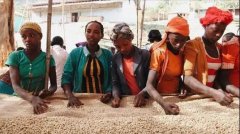Ethiopian Coffee Variety Daquan introduces what kind of coffee is the local native heirloom?

If you are reading about Ethiopian coffee production in the near future, you will begin to see the word "heirloom".
Although it is difficult to find a true definition of the phrase, in Ethiopia it is used as a general term for many wild or genetically undefined varieties in the country. For the third wave of coffee lovers, these strange and rare varieties are an exciting opportunity to try novel flavors.
To learn more about Ethiopian heirloom varieties, I talked to Biniyam Aklilu, director of Nardos Coffee, and Erik Liao, co-owner of Triup Coffee and chief baker of 19 Coffee Roasting Lab in Taiwan. Keep reading to get their opinions.
What does "family heirloom" mean?
According to the Oxford English Dictionary, the word "family heirloom" is defined as "the precious property of generations". Similarly, in the field of coffee, the term is widely used to refer to old varieties of Arabica coffee plants that have existed for some time.
However, especially in Ethiopia, the term "family heirloom" is often used to refer to the country's native species, many of which are still found in the wild today. It is estimated that there are about 10000 to 15000 family heirloom varieties in Ethiopia today, most of which have not yet been formally identified.
Although many family heirlooms began to live on wild plants, they were later taken to various specialty coffee farms across the country, where they were planted, harvested and processed.
Heirloom varieties are usually divided into two categories: JARC varieties and local varieties. JARC varieties are developed and studied by Jima Agricultural Research Center (with ideal characteristics, such as higher resistance to disease or higher yield). However, regional local varieties are coffee trees that grow entirely in the wild.
Erik told me that in Ethiopia, there is also a "semi-forest system" in which "large forest areas are (usually) owned by a private group".
"the difficulty with wild heirloom varieties is that they are wild," Erik said. "it is difficult for farmers to identify and separate varieties in the wild, while on farms, pickers and producers can better separate each variety."

Identify family heirlooms throughout Ethiopia
Among thousands of different family heirlooms in Ethiopia (whether identified or not), there are many different characteristics, including yield, cup quality, flavor and disease resistance.
However, one of the biggest problems with these thousands of heirloom coffee varieties is identification. This is partly due to the existence of a large number of genetically different varieties in Ethiopia. In addition, in some areas, many different varieties grow close to each other, so it is difficult to isolate and identify them.
Finally, heirloom varieties are usually identified only by producers based on years of experience, because there are so many varieties that it is almost impossible to carry out more extensive genetic verification.
At Nardos Coffee, Biniyam told me, they "go from one farmer to another to identify and understand every variety in the family heirloom". Although this is a labour-intensive process, it enables producers to share knowledge and therefore record only some of the data from thousands of Ethiopian heirloom varieties.
After identifying the varieties, Biniyam said Nardos Coffee tagged them. "now, varieties are named according to the year of discovery and the numerical order followed," he said. " Recording these data and marking these varieties can improve the traceability of the entire Ethiopian supply chain.
Although there are more than 10000 unique varieties in Ethiopia, it is difficult to grow any of them on a large scale. Each variety has its own unique requirements and is usually suitable for a region of the country.
"for example, the varieties of Badessa,Khudumi,Miqe,Sawa and Wolichu are indigenous to the Guji region," Biniyam explained. As a result, it is not always a good idea to transport varieties nationwide, he said.
'Even if you can grow plants from another area, the results may not be what you expect, 'says Erik. "for example, if you take a long rice from Sidamo and plant it in Guji, the result will be completely different. It will create a very different cup outline. "
Identifying and documenting differences between different varieties means that Nardos Coffee "can fine-tune its processing methods" to the local coffee they use, Biniyam said.
He added that the growing recognition of heirloom varieties has also provided support to Ethiopian producers. "We provide coffee saplings to more than 4000 farmers and provide them with farm management and financial support," Biniam said.
In addition to providing producers with more information about their varieties for use by potential buyers, thereby improving traceability, it also helps them maintain long-term stability.

Brief introduction of cup test
Usually, Ethiopian heirlooms tend to have flower-and-fruit-flavored cup-shaped contours, but the specific features vary widely from region to region.
Erik told me that in Guji, coffee tends to be very fruity, with berry and jam flavors, while in Sidamo, coffee is more floral and has a strong apricot flavor.
He also stressed the importance of purchasing a single variety and advised the roaster to be careful when mixing heirloom coffee. "I found that because Ethiopian heirlooms are so unique, mixing rather than separating varieties can really change the outline of the cup."
"for example, some of the coffee we buy will smell floral. However, if we mix a single variety with other varieties, the final mixture can show a soft floral flavor at the beginning, but end up with a fruity flavor. "
Biniyam explained that just like any coffee, care must be taken when processing heirloom varieties. He explained that Nados coffee uses water washing and natural processing (as well as fermentation experiments) to highlight the unique characteristics of each variety.
As for roasting Heriloom coffee, Erik said: "if I want to develop the exquisite complexity of heirloom coffee to make flower cups, I will bake it very quickly." Since the beans are usually small, we usually finish baking in a short development time. "
Ethiopia is the birthplace of coffee, and its thousands of family heirlooms make its origin different.
With the development of the industry, the increasing attention to data records will naturally provide support for producers to learn more about these wild species. This, in turn, leads to greater traceability, which supports communication and improves relationships throughout the supply chain.
Important Notice :
前街咖啡 FrontStreet Coffee has moved to new addredd:
FrontStreet Coffee Address: 315,Donghua East Road,GuangZhou
Tel:020 38364473
- Prev

Brewing flavor characteristics of Paradise Bird Coffee, known as the Little Blue Mountains in Papua New Guinea Coffee producing area
Professional coffee knowledge exchange more coffee bean information please follow Coffee Workshop (Wechat official account cafe_style) Papua New Guinea is an island in the southwestern Pacific Ocean. The first variety of iron pickup in Papua New Guinea was introduced from the Blue Mountains of Jamaica, and it also has the same island-type planting environment, so it is called Little Blue Mountain Coffee. Little Blue Mountain
- Next

The difference between the flavor of Yega Xuefei producing area by washing Yega Xuefei with Water and Solar Yega Sheffei in Ethiopia
Professional coffee knowledge exchange more coffee bean information please follow the coffee workshop (Wechat official account cafe_style) Yega Xuefei believes that we are not unfamiliar with a coffee producing area, its bright sour, clean and refreshing coffee flavor has become the first bean for many people to introduce boutique hand-brewed coffee. In the memory of many people, Yega Xuefei has always been washed with water.
Related
- Beginners will see the "Coffee pull flower" guide!
- What is the difference between ice blog purified milk and ordinary milk coffee?
- Why is the Philippines the largest producer of crops in Liberia?
- For coffee extraction, should the fine powder be retained?
- How does extracted espresso fill pressed powder? How much strength does it take to press the powder?
- How to make jasmine cold extract coffee? Is the jasmine + latte good?
- Will this little toy really make the coffee taste better? How does Lily Drip affect coffee extraction?
- Will the action of slapping the filter cup also affect coffee extraction?
- What's the difference between powder-to-water ratio and powder-to-liquid ratio?
- What is the Ethiopian local species? What does it have to do with Heirloom native species?

